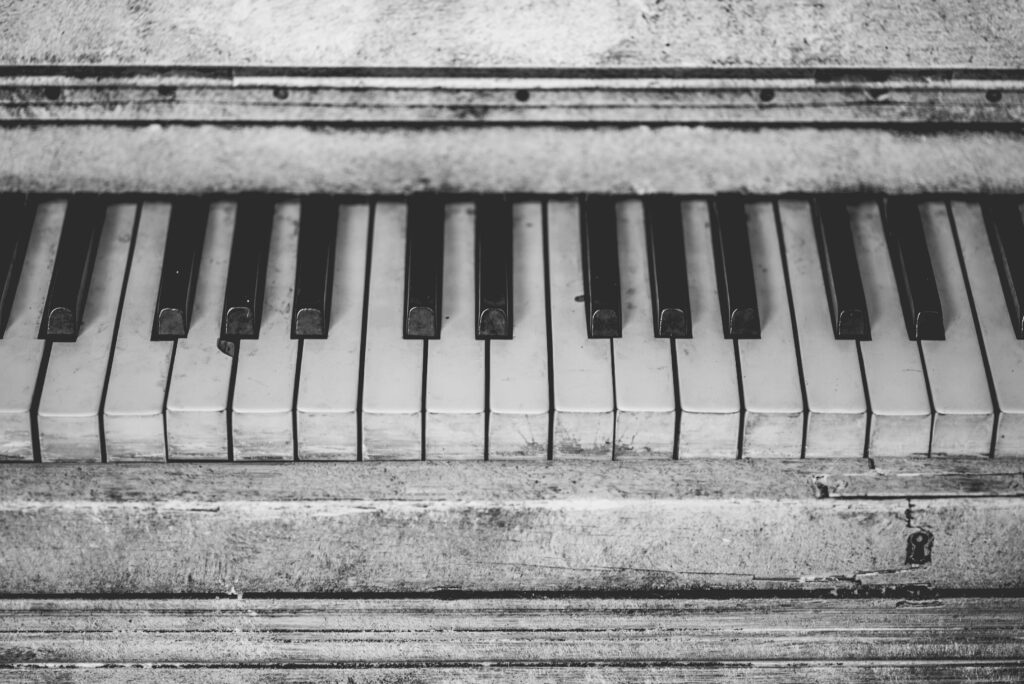Ever heard a song with a strange, beautiful harmony that felt unique and sophisticated? Chances are, polychords had something to do with it. Polychords are a secret weapon that can add rich layers and harmonic variation to any piece of music. In this guide, we will break down polychords, teach you how to play them and show you how to make this intriguing technique a part of your musical toolkit.
- Fall in love with the music - Learn your favorite songs, at a level suitable for you.
- Enjoy interactive piano lessons - Explore courses covering music theory, technique chords & more.
- Get real-time feedback - Skoove's feedback tells you what went well and what needs practice.

What is a polychord?
Polychords are two, or more, separate chords played together simultaneously, unlike regular chords, which consist of three or more notes stacked in a certain pattern (like major or minor). Polychords involve stacking chords on top of one another; these chordal combinations present the performer or composer with an incredibly wide and varied spectrum of harmonic possibilities.
Polychords are popular in genres like jazz, classical and even pop music, where complex harmonies and rich sounds can make a piece truly stand out.
Why play multiple chords at once?
If you’re looking to add unique textures and unexpected depth to your music, polychords are a fantastic tool. Here’s why:
- They add complexity: Polychords let you take ordinary chords and create something new by stacking them.
- They create tension: Combining chords can add unique tension and release to a song, helping guide the emotional arc of the music.
- They’re versatile: From mellow jazz tunes to epic film scores, polychords are a great addition to your musical palette.
Understanding the basics: breaking down a polychord
Let’s understand what makes a polychord. At its core, a polychord is the combination of two or more distinct piano chords that, when played together, create new and intriguing harmonies. As an introduction to the subject this article will focus on just two chord polychords.
What is a polychord made of?
A polychord is made up of multiple separate chords, typically from two different keys or harmonic regions. For example, you might stack an E major chord over a C major chord. Here’s how it looks:
- C Major: C, E, G
- E Major: E, G#, B
When played together, these chords form a unique sound that’s neither purely C major nor purely E major. Instead, you get a combination of both chords. This amalgamation brings out new harmonic possibilities that wouldn’t be achievable with one chord alone.
How are polychords notated
Polychords are a great way of writing out complex harmony in a simple to understand chord diagram that doesn’t involve vast amounts of complex chord extension notation/alteration.
When polychords are notated using a vertical line, the format indicates two distinct chords stacked on top of each other without implying a bass note relationship. For example:
- E | C: E major chord stacked over a C major chord.
- D | F♯m: D major chord stacked over an F♯ minor chord.
- B♭ | E♭: B♭ major chord stacked over an E♭ major chord.
This notation emphasizes the independence of the two chords, treating them as separate harmonic entities rather than a single chord with a bass note.
Chord families and polychord combinations
Not all chords work seamlessly together, so it will be helpful to revise basic chord qualities. The most common types are:
- Major chords: Bright and happy sounds (e.g. C major, G major).
- Minor chords: Darker, sadder tones (e.g., A minor, E minor).
- Augmented chords: Dreamy and ambiguous, adding a sense of mystery.
- Diminished chords: Tense, unsettling, often used to create suspense.
Step-by-step guide to building polychords
Ready to have a go? Playing polychords on the piano requires a bit of finesse and a solid understanding of technique, however with practice, it can become an integral part of your playing style. Here are some key techniques and tips to get you comfortable with polychords on the piano.
Hand positioning and finger technique
Playing two chords at once demands a certain level of finger independence and control. Start by practicing simple polychord structures where each hand plays only three notes at a time.
Position your hands comfortably: When you’re stacking two chords, make sure each hand’s positioning feels natural.
- If you’re playing a polychord like E over C (E|C), your left hand will handle the lower notes (C major) while your right hand takes the upper notes (E major). Place your hands so that each can comfortably reach all the notes without stretching too much.
Work on finger independence: To play polychords smoothly, each finger must be able to maintain its position without too much interference from the others.
- Start by practicing each chord individually in both hands until you’re comfortable with the fingerings. Then, try putting them together.
Let’s get practical! Follow these steps to start building your polychords.
Step 1: Start with two triads
A triad is a three note chord that includes a root note, a third, and a fifth. Triads are the building blocks of polychords. To make things easy, begin with simple major or minor triads. Here’s an example:
Cm|D
Top chord: C minor triad: C, E♭ ,G
Bottom chord: D major triad: D, F#, A
Now, stack these two triads, one on top of the other, to form a basic polychord. Notice how the piano notes combine to create a sound that’s uniquely expressive.
Step 2: Experiment with different chord positions
Polychords can take on many different forms by changing the chord inversions. Inversions shift the notes of a chord to a different position. For example, instead of playing C minor with C as the lowest note, try putting G or E♭ at the bottom.
Try this with your two triads:
- Inverting the top chord:
Top chord: C minor triad: E♭ ,G, C
Bottom chord: D major triad: D, F#, A
- Inverting the lower chord:
Top chord: C minor triad: C, E♭ ,G
Bottom chord: D major triad: A, D, F#
Each inversion, and inversion type, changes the sonance, emphasizing new colors in your polychord.
Step 3: Explore the space between chords and voicings
When playing polychords, don’t be afraid to leave a little space between the two chords. Spacing out the notes creates a more resonant, open sound, while closer voicings make the chord sound more compact.
Try playing the lower chord in one octave and the higher chord an octave above. This can help avoid a dense or cluttered sound. As mentioned above, you can also experiment with inversions of each chord, in addition to spacing, for a more variation in the sound.
Practice exercises overview:
Explore the art of polychords with these focused practice exercises. Develop your skills in voicings, inversions, and contrasting spacings for richer harmonic textures.
Exercise 1: Basic polychord voicings
Play E | C :
- Left hand: C major triad in root position: C – E -G.
- Right hand: E major triad in root position: E -G# -B.
Switch to E♭ | Cm:
- Left hand: C minor triad: C – E♭– C).
- Right hand: E♭major triad: E♭– G – B.
Repeat the sequence and experiment with dynamics.
Exercise 2: Inverted polychords
Play D | A♭:
- Left hand: D major in second inversion: A – D -F♯.
- Right hand: A♭ major in first inversion: C – E♭- A♭.
Transition to B | F:
- Left hand: B major in root position: B – D♯ – F♯.
- Right hand: F major in second inversion: C – F – A.
Experiment with pedal to sustain the harmonic textures.
Exercise 3: Contrasting spacings
Play Em | A:
- Left hand: Em in root position: E–G–B.
- Right hand: A major triad above by two octaves: E–A–C♯.
Switch to G | C:
- Left hand: G major in first inversion: B–D–G.
- Right hand: C major in root position above by two octaves: C–E–G.
Focus on smooth transitions between chord shapes.
Polychord exploration exercise:
Now you’ve grasped the basics, here is a handy way to explore all the polychord combinations you could ever want. This method will allow you to get familiar with the sound and feel of the full range polychords. Start with a C major triad then as shown in the cycle of fifths diagram below you can cycle the upper polychord round the cycle. Make note of how each of these combinations makes you feel and how the distance away from C affects the relationship of the chords.
Once you have thoroughly explored two major chords you can then experiment with other chord qualities for the upper chord, again progressing round the cycle. As before, note the feeling and relationships as you progress. Once you are happy with this you can start the process again with a new quality for lower chord. Don’t be afraid to experiment with voicings, spacing and chord extensions once you feel more comfortable just like we did in the exercises above.
As you will have noticed the relationship between the two chords in a polychord and their relative placement on the cycle of fifths significantly influences the harmonic feel and tension.
Here’s a breakdown:
Close relationship (near on the cycle of fifths)
When the chords are closely related (e.g., C | G or C | F), they share many common tones, resulting in a consonant, stable feel. These polychords are often used to create lush, expansive textures while remaining grounded in a tonal center.
Moderate relationship (further apart)
As the chords move farther apart on the cycle (e.g, C | E or C | B♭), the harmonic feel becomes more ambiguous and colorful. There are fewer shared tones between the chords which introduces a subtle tension while still being manageable in tonal contexts.
Distant relationship (opposite on the cycle)
When the chords are far apart (e.g., C | F♯), they share no common tones, creating maximum tension and dissonance. These combinations produce a jarring, modern feel and are often used in avant-garde, experimental music or moments of high drama.
Practical application
Experimenting with polychords along the cycle of fifths lets you control the emotional impact of your harmony:
- Use closer relationships for warmth and richness.
- Explore moderate distances for complexity and intrigue.
- Try distant pairs for bold, striking tension.
This may all seem like an overwhelming amount of combinations to keep track of but think of the word of harmonic possibilities now available to you! You can incorporate polychords into your playing and writing as you feel comfortable and progress your use of these interesting combinations as you gain confidence. It’s always best to play with guidance, Skoove can help with that, check out interactive lessons for real time practice guidance.
The role of polychords in musical expression
Polychords are more than just an intriguing musical tool, they’re a powerful way to express complex emotions and evoke responses in listeners that single chords might not be able to achieve.
Enhancing emotional depth
Polychords are a powerful tool for expressing complex emotions, offering harmonic colors and textures that go beyond single chords. By layering chords, musicians can create nuanced, multidimensional sounds that captivate listeners.
Creating tension and release
Polychords excel at introducing tension and release. Combining contrasting chords generates suspense and anticipation. This dynamic keeps the audience engaged, making polychords invaluable in genres like jazz and electronic music, where mood shifts are essential.
Gil Evans’ arrangements on Miles Davis’ Concierto De Aranjuez makes use of polychords to create a unique phrygian feel. This is achieved through subtle use of a C# major tonality over D minor. The inclusion of #5 of D through the C# maj emphasizes the tensions and phrygian aspects of the piece.
Adding richness to compositions
Polychords add depth by blending tonalities to form unique harmonic qualities, making them perfect for conveying atmospheres or emotional colors. Composers often use polychords in film music to reflect complex emotions or heighten dramatic moments.
This is One of the most famous and overt examples of a polychord is Stravinsky’s “Rite of Spring chord” featuring an E♭7 chord layered over an F♭ major chord, heard prominently in the “Dance of the Adolescents.”
The difference between polychords and polytonality
As we have seen polychords are a harmonic device where two or more chords are played simultaneously. Polytonality, on the other hand, involves using two or more distinct tonal centers (keys) at the same time. Unlike polychords, which focus on individual harmonic combinations, polytonality impacts the structure, melody, progression and overall harmony of the piece. A melody might be written in one key, while the accompaniment exists in another, creating a layered and often ambiguous sound.
Polychords vs. Polytonality
- Polychords are localized harmonic events (e.g. D | A♭), often used for texture or color within a single tonal context.
- Polytonality defines the overarching structure, with multiple keys existing simultaneously across a composition or section.
This is an important distinction to make as both techniques challenge traditional harmonic conventions, offering unique ways to expand and enrich musical expression. However it’s important not to confuse the two and let your polychords stray into creating a sense of polytonality unintentionally.
Where can I find polychords in music?
- Igor Stravinsky – The Rite of Spring
The previously discussed “E♭7 over F♭ major” chord in The Rite of Spring creates raw tension and an earthy, primal atmosphere.
- Aaron Copland – Appalachian Spring
Polychords are used to evoke open, expansive landscapes, blending harmonic layers for emotional depth.
- Herbie Hancock – Maiden Voyage
Hancock makes use of polychordal modal voicings, creating ethereal and open textures.
- John Williams – Close Encounters of the Third Kind
Polychords are used to evoke mystery and tension, particularly in the alien communication motifs.
- Olivier Messiaen – Quartet for the End of Time
Polychordal layering creates ethereal, otherworldly harmonies central to Messiaen’s spiritual and experimental style.
These works clearly demonstrate how polychords can transform compositions across genres, from classical to modern music, enhancing emotional storytelling and harmonic depth.
Tips for success with polychords
Here are some tips to keep in mind while practicing and playing polychords.
- Start simple: Don’t jump into complicated chord combinations too soon; take time to master basic ones first.
- Listen to your sound: Record yourself and listen back. This will help you hear the impact of different polychord pairings.
- Experiment with genres: Jazz, pop, classical, each genre brings out different qualities in polychords, so explore widely.
- Learn from the pros: Listen to musicians known for their mastery of polychords for inspiration and ideas.
- Make your own progressions: Start by adding polychords to progressions you already know then branch out to writing your own.
Common mistakes and how to avoid them
Here are a few common pitfalls when learning polychords:
- Over-complicating early on: Keep it simple to avoid frustration. Master the basics before moving on to more complex chords.
- Ignoring hand positioning: Poor positioning can lead to tension making it harder to integrate polychords naturally.
- Neglecting dynamics: It’s easy to play too loudly when experimenting with two chords.
Conclusion
Polychords are a powerful and versatile tool that can elevate your music. Whether you’re composing, improvising, or arranging, they open up endless creative possibilities. By layering two or more chords, you can explore new harmonic textures, create dynamic tension and release and infuse your music with rich emotional storytelling. From jazz to classical and film scores, polychords are a hallmark of innovation and sophistication.Now that you’ve mastered the basics, it’s time to start experimenting. Try incorporating polychords into your progressions, exploring different voicings, genres and techniques. With time and practice, they’ll become an integral part of your musical voice. For a guided learning experience, Skoove offers interactive lessons and personalized feedback to help you refine your skills and take your polychord exploration to the next level. Dive in, experiment and let polychords unlock a whole new dimension of creativity in your music!
Author of this blog post:
Matthew Dickman

With over a decade of experience in music education Matthew holds a BA in Music from Paul McCartney’s LIPA and an MA in Composition from the University of Salford. Mathew has developed a distinctive compositional voice and approach to music theory education through his research and work in the music industry. Matthew’s writing for Skoove combines experience from orchestral and media composition, and as a gigging jazz musician, to create a wholistic and accessible pedagogy for musicians of any level. Away from music, he enjoys reading and exploring nature to expand his horizons and knowledge contributing to his holistic teaching style.















